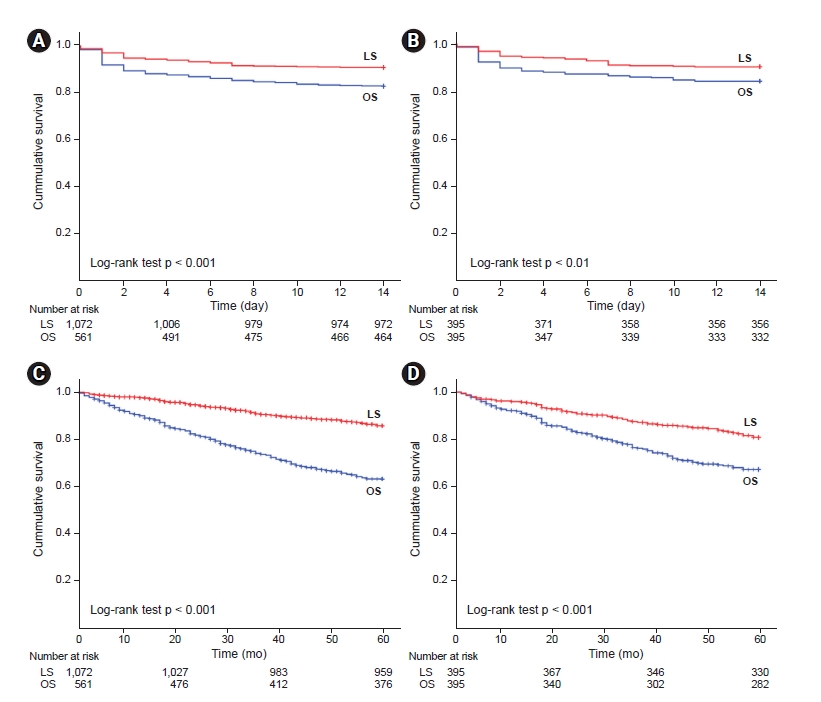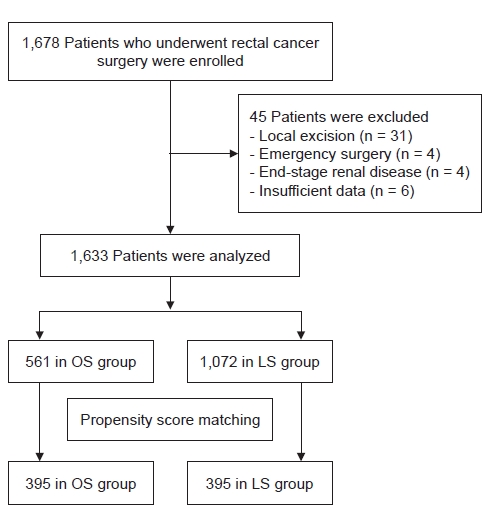1. Kidney Disease: Improving Global Outcomes (KDIGO) Acute Kidney Injury Work Group. KDIGO Clinical Practice Guideline for Acute Kidney Injury. Kidney Int Suppl 2012;2:1–138.
2. Chertow GM, Burdick E, Honour M, Bonventre JV, Bates DW. Acute kidney injury, mortality, length of stay, and costs in hospitalized patients.
J Am Soc Nephrol 2005;16:3365–3370.


3. Lameire NH, Bagga A, Cruz D, et al. Acute kidney injury: an increasing global concern.
Lancet 2013;382:170–179.


4. Thakar CV, Christianson A, Freyberg R, Almenoff P, Render ML. Incidence and outcomes of acute kidney injury in intensive care units: a Veterans Administration study.
Crit Care Med 2009;37:2552–2558.


5. Uchino S, Kellum JA, Bellomo R, et al. Acute renal failure in critically ill patients: a multinational, multicenter study.
JAMA 2005;294:813–818.


6. Thakar CV. Perioperative acute kidney injury.
Adv Chronic Kidney Dis 2013;20:67–75.


7. Bihorac A, Yavas S, Subbiah S, et al. Long-term risk of mortality and acute kidney injury during hospitalization after major surgery.
Ann Surg 2009;249:851–858.


8. Kim CS, Bae EH, Ma SK, Kweon SS, Kim SW. Impact of transient and persistent acute kidney injury on chronic kidney disease progression and mortality after gastric surgery for gastric cancer.
PLoS One 2016;11:e0168119.



9. Veldkamp R, Kuhry E, Hop WC, et al. Laparoscopic surgery versus open surgery for colon cancer: short-term outcomes of a randomised trial.
Lancet Oncol 2005;6:477–484.


10. Moon YJ, Jun IG, Kim KH, Kim SO, Song JG, Hwang GS. Comparison of acute kidney injury between open and laparoscopic liver resection: propensity score analysis.
PLoS One 2017;12:e0186336.



11. Park YS, Jun IG, Go Y, Song JG, Hwang GS. Comparison of acute kidney injury between open and laparoscopic pylorus-preserving pancreaticoduodenectomy: propensity score analysis.
PLoS One 2018;13:e0202980.



12. Quintana JM, Anton-Ladislao A, Lázaro S, et al. Outcomes of open versus laparoscopic surgery in patients with rectal cancer.
Int J Colorectal Dis 2018;33:99–103.


13. Greenblatt DY, Rajamanickam V, Pugely AJ, Heise CP, Foley EF, Kennedy GD. Short-term outcomes after laparoscopic-assisted proctectomy for rectal cancer: results from the ACS NSQIP.
J Am Coll Surg 2011;212:844–854.



14. Keys A, Fidanza F, Karvonen MJ, Kimura N, Taylor HL. Indices of relative weight and obesity.
J Chronic Dis 1972;25:329–343.


15. Saklad M. Grading of patients for surgical procedures.
Anesthesiology 1941;2:281–284.

16. Lenoir B, Merckx P, Paugam-Burtz C, et al. Individual probability of allogeneic erythrocyte transfusion in elective spine surgery: the predictive model of transfusion in spine surgery.
Anesthesiology 2009;110:1050–1060.


17. Hobson C, Singhania G, Bihorac A. Acute kidney injury in the surgical patient.
Crit Care Clin 2015;31:705–723.



18. Wehbe E, Brock R, Budev M, et al. Short-term and long-term outcomes of acute kidney injury after lung transplantation.
J Heart Lung Transplant 2012;31:244–251.


19. Park S, Cho H, Park S, et al. Simple Postoperative AKI Risk (SPARK) Classification before noncardiac surgery: a prediction index development study with external validation.
J Am Soc Nephrol 2019;30:170–181.


20. Park S, Baek SH, Ahn S, et al. Impact of electronic Acute Kidney Injury (AKI) alerts with automated nephrologist consultation on detection and severity of AKI: a quality improvement study.
Am J Kidney Dis 2018;71:9–19.


21. Rothman KJ. Synergy and antagonism in cause-effect relationships.
Am J Epidemiol 1974;99:385–388.

22. Lim SY, Lee JY, Yang JH, et al. Predictive factors of acute kidney injury in patients undergoing rectal surgery.
Kidney Res Clin Pract 2016;35:160–164.



23. Slagelse C, Gammelager H, Iversen LH, Sørensen HT, Christiansen CF. Acute kidney injury and 1-year mortality after colorectal cancer surgery: a population-based cohort study.
BMJ Open 2019;9:e024817.



24. Rasmussen JP, Dauchot PJ, DePalma RG, et al. Cardiac function and hypercarbia.
Arch Surg 1978;113:1196–1200.


25. Dunn MD, McDougall EM. Renal physiology. Laparoscopic considerations.
Urol Clin North Am 2000;27:609–614.

26. McDougall EM, Monk TG, Wolf JS Jr, et al. The effect of prolonged pneumoperitoneum on renal function in an animal model.
J Am Coll Surg 1996;182:317–328.

27. Chang DT, Kirsch AJ, Sawczuk IS. Oliguria during laparoscopic surgery.
J Endourol 1994;8:349–352.


28. Shuto K, Kitano S, Yoshida T, Bandoh T, Mitarai Y, Kobayashi M. Hemodynamic and arterial blood gas changes during carbon dioxide and helium pneumoperitoneum in pigs.
Surg Endosc 1995;9:1173–1178.


29. Nguyen NT, Cronan M, Braley S, Rivers R, Wolfe BM. Duplex ultrasound assessment of femoral venous flow during laparoscopic and open gastric bypass.
Surg Endosc 2003;17:285–290.


30. Joo EY, Moon YJ, Yoon SH, Chin JH, Hwang JH, Kim YK. Comparison of acute kidney injury after robot-assisted laparoscopic radical prostatectomy versus retropubic radical prostatectomy: a propensity score matching analysis.
Medicine (Baltimore) 2016;95:e2650.



31. Karkouti K, Wijeysundera DN, Yau TM, et al. Acute kidney injury after cardiac surgery: focus on modifiable risk factors.
Circulation 2009;119:495–502.


32. Almac E, Ince C. The impact of storage on red cell function in blood transfusion.
Best Pract Res Clin Anaesthesiol 2007;21:195–208.


33. Jacobs M, Verdeja JC, Goldstein HS. Minimally invasive colon resection (laparoscopic colectomy).
Surg Laparosc Endosc 1991;1:144–150.

34. Colon Cancer Laparoscopic or Open Resection Study Group, Buunen M, Veldkamp R, et al. Survival after laparoscopic surgery versus open surgery for colon cancer: long-term outcome of a randomised clinical trial.
Lancet Oncol 2009;10:44–52.


35. Lacy AM, García-Valdecasas JC, Delgado S, et al. Laparoscopy-assisted colectomy versus open colectomy for treatment of non-metastatic colon cancer: a randomised trial.
Lancet 2002;359:2224–2229.


36. Bonjer HJ, Deijen CL, Abis GA, et al. A randomized trial of laparoscopic versus open surgery for rectal cancer.
N Engl J Med 2015;372:1324–1332.


37. Fleshman J, Branda M, Sargent DJ, et al. Effect of laparoscopic-assisted resection vs open resection of stage II or III rectal cancer on pathologic outcomes: the ACOSOG Z6051 randomized clinical trial.
JAMA 2015;314:1346–1355.



38. Milone M, Manigrasso M, Burati M, Velotti N, Milone F, De Palma GD. Surgical resection for rectal cancer. Is laparoscopic surgery as successful as open approach? A systematic review with meta-analysis.
PLoS One 2018;13:e0204887.



39. Benson AB, Venook AP, Al-Hawary MM, et al. Rectal cancer, version 2.2018, NCCN Clinical Practice Guidelines in Oncology.
J Natl Compr Canc Netw 2018;16:874–901.



40. Schnitzbauer V, Gerken M, Benz S, et al. Laparoscopic and open surgery in rectal cancer patients in Germany: short and long-term results of a large 10-year population-based cohort.
Surg Endosc 2020;34:1132–1141.





















 PDF Links
PDF Links PubReader
PubReader ePub Link
ePub Link Full text via DOI
Full text via DOI Download Citation
Download Citation Supplement 1
Supplement 1 Print
Print















